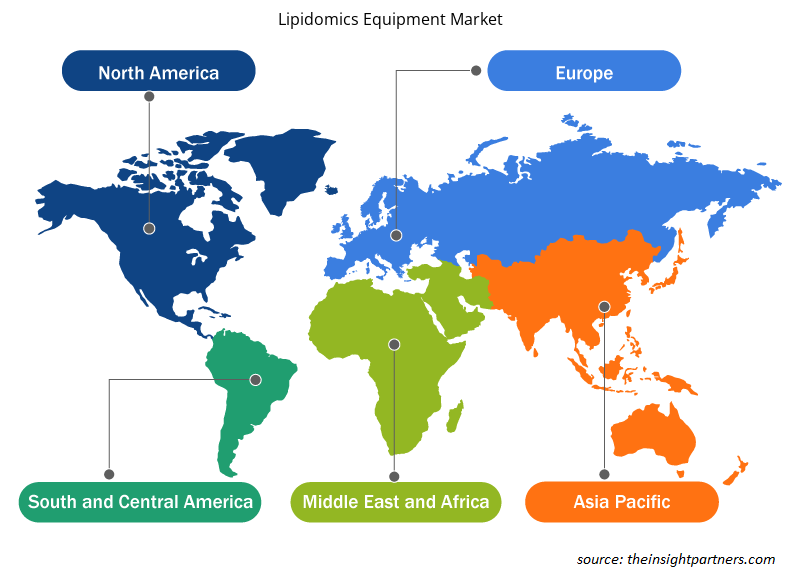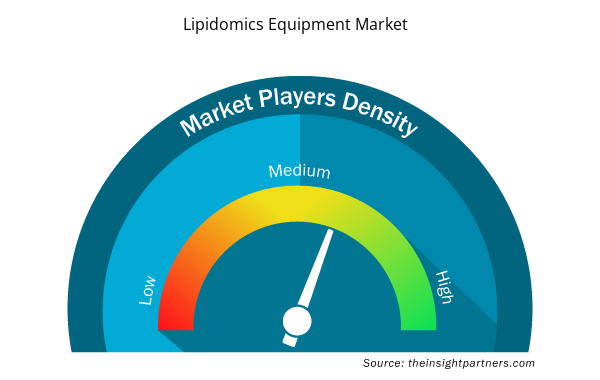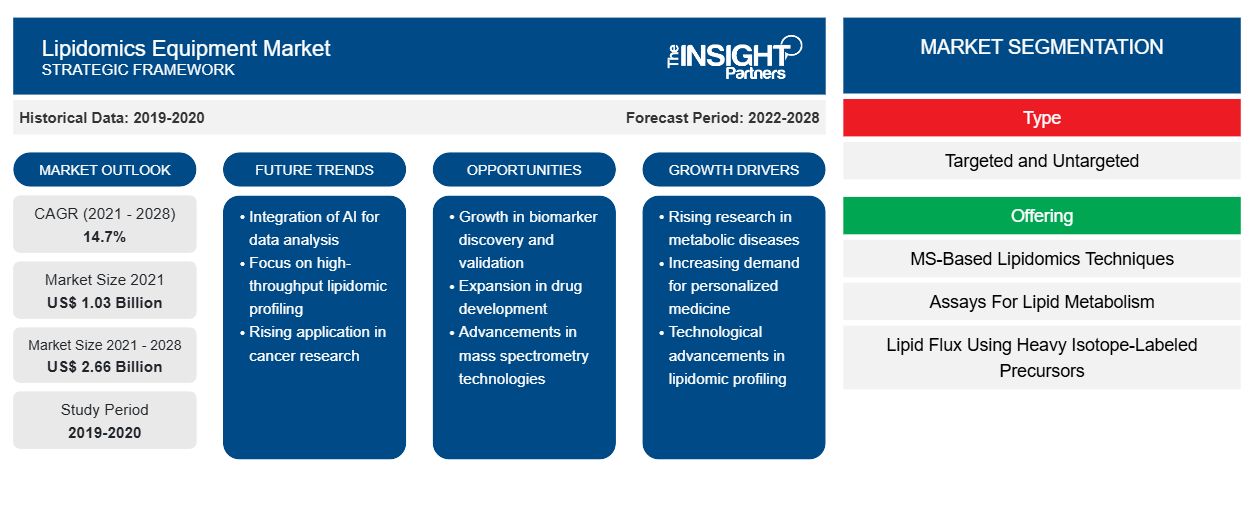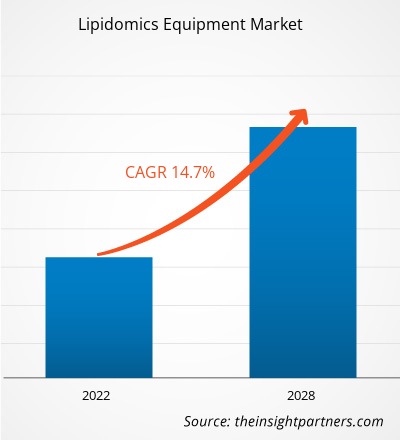Der Markt für Lipidomik-Geräte wurde im Jahr 2021 auf 1.025,38 Millionen US-Dollar geschätzt und dürfte von 2022 bis 2028 mit einer durchschnittlichen jährlichen Wachstumsrate von 14,7 % wachsen.lipidomics equipment market was valued at US$ 1,025.38 million in 2021 and it is expected to grow at a CAGR of 14.7% from 2022 to 2028.
Das Wachstum des Marktes ist auf die technologischen Fortschritte in der Massenspektrometrie und die zunehmende Anwendung der Lipidomik in den biomedizinischen Wissenschaften zurückzuführen. Allerdings schränken die hohen Produktpreise das Wachstum des Marktes für Lipidomik-Ausrüstung ein . Die Lipidomik, eine aufstrebende Disziplin der biomedizinischen Wissenschaften, umfasst die Charakterisierung komplexer Lipidome. Die Lipidom-Charakterisierung basiert auf einer Quantifizierung auf Systemebene und der Erkennung mehrerer Netzwerke und Wege zellulärer Lipide sowie ihrer Interaktion mit anderen Einheiten und Proteinen. Der Bedarf an einer genauen Krankheitsdiagnose, die wachsende Nachfrage nach personalisierten Medikamenten, technologische Fortschritte in der Lipidomik und enorme Investitionen des öffentlichen und privaten Sektors in F&E-Aktivitäten werden das Marktwachstum im Prognosezeitraum weiter vorantreiben.
Passen Sie diesen Bericht Ihren Anforderungen an
Sie erhalten kostenlos individuelle Anpassungen an jedem Bericht, einschließlich Teilen dieses Berichts oder einer Analyse auf Länderebene, eines Excel-Datenpakets sowie tolle Angebote und Rabatte für Start-ups und Universitäten.
- Holen Sie sich die wichtigsten Markttrends aus diesem Bericht.Dieses KOSTENLOSE Beispiel umfasst eine Datenanalyse von Markttrends bis hin zu Schätzungen und Prognosen.
Der asiatisch-pazifische Raum gilt als die am schnellsten wachsende Region auf dem globalen Markt für Lipidomik-Ausrüstung. China, Japan und Indien zählen zu den wichtigsten Marktteilnehmern in dieser Region. Investitionen internationaler Akteure in China und Indien, wachsende staatliche Unterstützung in den Ländern, florierende Kooperationen zwischen Forschungsorganisationen, eine steigende Zahl von Forschungsinstituten für Lipidomik-Ausrüstung und Fortschritte in der Gesundheitsinfrastruktur gehören zu den Schlüsselfaktoren, die den Markt für Lipidomik-Ausrüstung im asiatisch-pazifischen Raum ankurbeln.
Markteinblicke
Technologische Fortschritte in der Massenspektrometrie treiben das Wachstum des Marktes für Lipidomik-Geräte voran
Massenspektrometer werden häufig zur Identifizierung und Quantifizierung von Lipiden verwendet. Die hochenergetische kollisionsaktivierte Dissoziationstechnik (CAD) der Massenspektrometrie führt zu Charge Remote Fragmentation-Reaktionen (CRF), die dabei helfen, die Position kleiner struktureller Bindungsdetails zu ermitteln. Forschern und Technikern stehen mehrere fortschrittliche Massenspektrometer zur Verfügung, darunter Sektormassenspektrometrie, Matrix-unterstützte Laserdesorptions-Ionisations-Flugzeitmessung (MALDI-TOF), Flüssigkeitschromatographie-Massenspektrometrie (LC-MS) und Tandem-Massenspektrometer. Darüber hinaus werden diese Instrumente mit Automatisierung, Miniaturisierung, künstlicher Intelligenz (KI) und intelligenten Technologien integriert, um ihre Effizienz und Genauigkeit zu verbessern.collisional-activated dissociation (CAD) technique of mass spectrometry results in charge remote fragmentation (CRF) reactions, which help detect the location of small structural bond details. Several advanced spectrometry, matrix-assisted laser desorption ionization-time-of-flight (MALDI-TOF), liquid chromatography-mass spectrometry (LC-MS), and tandem mass spectrometer have been made available for researchers and technicians. Further, these instruments are being integrated with automation, miniaturization, artificial intelligence (AI), and smart technologies to enhance their efficiencies and accuracies.
Im Jahr 2018 brachte Thermo Scientific das UV/Vis-Spektrometer Genesys 50 auf den Markt, das eine Einzelzellenkonfiguration aufweist, die für geringe Probendurchsatzanforderungen geeignet ist und über ein abnehmbares, waschbares Probenfach zur einfachen Reinigung verfügt. Im selben Jahr brachte Shimadzu in Zusammenarbeit mit PREMIER Biosoft das LCMS-9030 Quadrupole Time of Flight (Q-TOF)-Massenspektrometriesystem (MS) von Shimadzu für die Lipidomik- und Glykomik- Datenanalyse auf den Markt. Das Produkt verfügt über Informatikunterstützung durch Softwarelösungen von PREMIER Biosoft. Im Jahr 2019 stellte TTP Venus Ltd eine Reihe neuer Mikropumpen mit verbesserter Leistung, höheren Durchflussraten, hohem Druck und längerer Lebensdauer vor. Die Einführung dieser neuen verbesserten Massenspektrometer und Mikropumpen fördert das Wachstum des Marktes für Lipidomik-Geräte.Thermo Scientific launched Genesys 50 UV/vis spectrometer that has a single cell configuration, which is suitable for low sample throughput needs, with a removable, washable sampling compartment for easy clean-up. In the same year, Shimadzu, in collaboration with PREMIER Biosoft, launched Shimadzu's LCMS-9030 Quadrupole Time of Flight (Q-TOF) mass spectrometry (MS) system for lipidomics and Biosoft. In 2019, TTP Venus Ltd introduced a range of new micropumps with enhanced performance, higher flow rates, high pressures, and longer life. The introduction of such new enhanced mass spectrometers and micropumps is boosting the growth of the lipidomics equipment market.
Typbasierte Erkenntnisse
Der Markt für Lipidomik-Geräte wird nach Typ in zielgerichtete und nicht zielgerichtete Geräte unterteilt. Das zielgerichtete Segment hatte 2021 einen größeren Marktanteil und wird voraussichtlich zwischen 2021 und 2028 eine höhere durchschnittliche jährliche Wachstumsrate verzeichnen. Gezielte Lipidomik-Geräte werden hauptsächlich zur Analyse von Signalverarbeitungspfaden verwendet. Schnelle Fortschritte bei Techniken und deren Anwendungen können eine rechtzeitige Überprüfung dieser Aspekte unerlässlich machen.lipidomics equipment market is segmented into targeted and untargeted. The targeted segment held a larger share of the market in 2021, and it is anticipated to register a higher CAGR during 2021–2028. Targeted lipidomics equipment are mainly used for analyzing signal processing pathways. Rapid advancements in techniques and their applications are capable of making a timely review of these aspects essential.
Angebotsbasierte Erkenntnisse
Basierend auf dem Angebot ist der Markt für Lipidomik-Geräte segmentiert in MS-basierte Lipidomik-Techniken, Tests für den Fettstoffwechsel, Lipidfluss unter Verwendung isotopenmarkierter Vorläufer, Software und Dienstleistungen und andere. Das Segment der MS-basierten Lipidomik-Techniken hatte 2021 den größten Marktanteil und wird im Prognosezeitraum voraussichtlich die höchste durchschnittliche jährliche Wachstumsrate (CAGR) auf dem Markt verzeichnen.
Servicebasierte Einblicke
Basierend auf dem Service ist der Markt für Lipidomik-Geräte segmentiert in Biomarker-Identifizierung, bioinformatische Analyse und Dateninterpretation, molekulare Analyse eines breiten Spektrums von Phospholipiden (Lipid-Fingerprinting), Analyse und Identifizierung ungewöhnlicher Lipide, semiquantitative und quantitative Analyse, Lipidflussstudien und andere. Das Segment der Biomarker-Identifizierung hatte 2021 den größten Marktanteil und wird im Prognosezeitraum voraussichtlich die höchste CAGR verzeichnen. Die Biomarker-Identifizierung ist die am weitesten verbreitete Methode zur Diagnose chronischer Krankheiten wie Krebs und Nierenerkrankungen.lipidomics equipment market is segmented into biomarker identification, bioinformatic analysis & data interpretation, molecular analysis of a broad spectrum of phospholipids (lipid fingerprinting), analysis & identification of unusual lipids, semiquantitative & quantitative analysis, lipid flux studies, and others. The biomarker identification segment held the largest share of the market in 2021, and it is estimated to register the highest CAGR during the forecast period. Biomarker identification is the most widely used method for the diagnoses of chronic diseases, such as cancer and kidney disorders.
Endbenutzerbasierte Erkenntnisse
Basierend auf dem Endverbraucher ist der Markt für Lipidomik-Ausrüstung in die Bereiche Molekularforschung, Zellforschung, klinische Forschung, Gewebe- und Organforschung, Datenforschung, Organismusforschung, technische Dienste und Prototyping, Produktion und andere unterteilt. Das Segment Molekularforschung hatte im Jahr 2021 den größten Marktanteil und wird im Prognosezeitraum voraussichtlich die höchste durchschnittliche jährliche Wachstumsrate verzeichnen.
Unternehmen, die auf dem Markt für Lipidomik-Ausrüstung tätig sind, verfolgen eine Strategie der Produktinnovation, um den sich entwickelnden Kundenanforderungen weltweit gerecht zu werden und so ihren Markennamen auf dem Weltmarkt zu behaupten.
Regionale Einblicke in den Markt für Lipidomik-Geräte
Die regionalen Trends und Faktoren, die den Markt für Lipidomik-Ausrüstung während des gesamten Prognosezeitraums beeinflussen, wurden von den Analysten von Insight Partners ausführlich erläutert. In diesem Abschnitt werden auch die Marktsegmente und die Geografie für Lipidomik-Ausrüstung in Nordamerika, Europa, im asiatisch-pazifischen Raum, im Nahen Osten und Afrika sowie in Süd- und Mittelamerika erörtert.

- Erhalten Sie regionale Daten zum Markt für Lipidomik-Geräte
Umfang des Marktberichts zu Lipidomik-Geräten
| Berichtsattribut | Details |
|---|---|
| Marktgröße im Jahr 2021 | 1,03 Milliarden US-Dollar |
| Marktgröße bis 2028 | 2,66 Milliarden US-Dollar |
| Globale CAGR (2021 - 2028) | 14,7 % |
| Historische Daten | 2019-2020 |
| Prognosezeitraum | 2022–2028 |
| Abgedeckte Segmente | Nach Typ
|
| Abgedeckte Regionen und Länder | Nordamerika
|
| Marktführer und wichtige Unternehmensprofile |
|
Dichte der Marktteilnehmer für Lipidomik-Ausrüstung: Die Auswirkungen auf die Geschäftsdynamik verstehen
Der Markt für Lipidomik-Ausrüstung wächst rasant, angetrieben durch die steigende Nachfrage der Endnutzer aufgrund von Faktoren wie sich entwickelnden Verbraucherpräferenzen, technologischen Fortschritten und einem größeren Bewusstsein für die Vorteile des Produkts. Mit steigender Nachfrage erweitern Unternehmen ihr Angebot, entwickeln Innovationen, um die Bedürfnisse der Verbraucher zu erfüllen, und nutzen neue Trends, was das Marktwachstum weiter ankurbelt.
Die Marktteilnehmerdichte bezieht sich auf die Verteilung der Firmen oder Unternehmen, die in einem bestimmten Markt oder einer bestimmten Branche tätig sind. Sie gibt an, wie viele Wettbewerber (Marktteilnehmer) in einem bestimmten Marktraum im Verhältnis zu seiner Größe oder seinem gesamten Marktwert präsent sind.
Die wichtigsten auf dem Markt für Lipidomik-Ausrüstung tätigen Unternehmen sind:
- Thermofisher Scientific
- Kreative Proteomik
- Ionenbank
- Shimadzu Europe GmbH
- Bruker
Haftungsausschluss : Die oben aufgeführten Unternehmen sind nicht in einer bestimmten Reihenfolge aufgeführt.

- Überblick über die wichtigsten Akteure auf dem Markt für Lipidomik-Ausrüstung
Markt für Lipidomik-Geräte: Segmentübersicht
- Der Markt für Lipidomik-Geräte wird nach Typ in zielgerichtete und nicht zielgerichtete Geräte unterteilt. Im Jahr 2021 hatte das zielgerichtete Segment einen größeren Marktanteil; für das nicht zielgerichtete Segment wird jedoch von 2022 bis 2028 eine höhere durchschnittliche jährliche Wachstumsrate erwartet.
- Basierend auf dem Angebot ist der Markt für Lipidomik-Ausrüstung segmentiert in MS-basierte Lipidomik-Techniken, Tests für den Lipidstoffwechsel, Lipidfluss unter Verwendung schwerer Isotopen-markierter Vorläufer, Software & Dienstleistungen und andere. Das Segment der MS-basierten Lipidomik-Techniken ist weiter segmentiert in Massenspektrometer, die mit Ionenquellen (Turbo-) ESI/Nano-ESI/APCI, Autosampler, Mikropumpen, UV-Detektoren, UPLC, Fluoreszenzdetektoren mit variabler Länge und andere ausgestattet sind. Das Segment der MS-basierten Lipidomik-Techniken hatte 2021 den größten Marktanteil; jedoch wird erwartet, dass das Segment Software & Dienstleistungen im Prognosezeitraum die höchste CAGR verzeichnen wird.
- Basierend auf dem Service ist der Markt für Lipidomik-Geräte segmentiert in Biomarker-Identifizierung, bioinformatische Analyse und Dateninterpretation, molekulare Analyse eines breiten Spektrums von Phospholipiden (Lipid-Fingerprinting), Analyse und Identifizierung ungewöhnlicher Lipide, semiquantitative und quantitative Analyse, Lipidflussstudien und andere. Das Segment Biomarker-Identifizierung hatte 2021 den größten Marktanteil; jedoch wird erwartet, dass das Segment bioinformatische Analyse und Dateninterpretation im Prognosezeitraum die höchste durchschnittliche jährliche Wachstumsrate verzeichnet.
- Basierend auf dem Endverbraucher ist der Markt für Lipidomik-Geräte in die Bereiche Molekularforschung, Zellforschung, klinische Forschung, Gewebe- und Organforschung, Datenforschung, Organismusforschung, technische Dienste und Prototyping, Produktion und andere unterteilt. Das Segment Molekularforschung hatte 2021 den größten Marktanteil; jedoch wird erwartet, dass das Segment klinische Forschung im Prognosezeitraum die höchste durchschnittliche jährliche Wachstumsrate verzeichnet.
Markt für Lipidomik-Ausrüstung: Wettbewerbslandschaft und wichtige Entwicklungen
Zum Markt für Lipidomik-Ausrüstung gehören Thermofisher Scientific, Creative Proteomics, IonBench, Shimadzu Europe GMbH, Bruker, Agilent Technologies Inc, PerkinElmer, Inc., Sciex, Metabolon, Inc. und Cayman Chemical. Diese Akteure konzentrieren sich auf die Expansion, Diversifizierung ihrer Marktpräsenz und den Aufbau eines neuen Kundenstamms, um so bestehende Geschäftsmöglichkeiten zu nutzen.
- Historische Analyse (2 Jahre), Basisjahr, Prognose (7 Jahre) mit CAGR
- PEST- und SWOT-Analyse
- Marktgröße Wert/Volumen – Global, Regional, Land
- Branche und Wettbewerbsumfeld
- Excel-Datensatz



Report Coverage
Revenue forecast, Company Analysis, Industry landscape, Growth factors, and Trends

Segment Covered
This text is related
to segments covered.

Regional Scope
North America, Europe, Asia Pacific, Middle East & Africa, South & Central America

Country Scope
This text is related
to country scope.
Häufig gestellte Fragen
Global lipidomics equipment market is segmented by region into North America, Europe, Asia Pacific, South & Central America, and Middle East & Africa. Geographically, North America accounted for the largest share of the global lipidomics equipment market in 2021, followed by Europe. Compared to this, Asia-Pacific is expected to grow at the highest CAGR in the forecast period.
The molecular research segment segment dominated the global lipidomics equipment market and accounted for the largest market share of 27.26% in 2021.
As Thermofisher Scientific; Creative Proteomics; IonBench; Shimadzu Europe GMbH; Bruker; Agilent Technologies Inc; PerkinElmer, Inc.; Sciex; Metabolon, Inc.; Cayman Chemical; among others are the leading companies operating in the global lipidomics equipment market.
Based on type, targeted segment held the largest market share in 2021 and is expected to continue to do so until the forecast period.
Based on products, semi-electric beds segment held the largest share of the market in 2021; however, the electric beds segment is anticipated to register the highest CAGR during the forecast period.
The global lipidomics equipment market is being driven by factors such as growing appplications of lipidomics in biomedical research and technological advancements in mass spectrometer. Furthermore, escalating government and market players investment in emerging countries is likely to offer significant opportunities for the growth of the global sex toy market.
Lipidomics is an emerging field of biological science that involves the analysis of lipids. Lipidomics involves system-level quantitation and identification of several networks and pathways of cellular lipids and interaction with other proteins and moieties. The need for accurate disease diagnosis, growth in demand for personalized medicine, technological advancements in lipidomics, and huge investments from the public and private sectors for R&D activities are anticipated to fuel the market growth over the forecast period.
Trends and growth analysis reports related to Life Sciences : READ MORE..
The List of Companies - Lipidomics Equipment Market
- Thermofisher Scientific
- Creative Proteomics
- IonBench
- Shimadzu Europe GMbH
- Bruker
- Agilent Technologies Inc.
- PerkinElmer, Inc.
- Sciex
- Metabolon, Inc.
- Cayman Chemical
The Insight Partners performs research in 4 major stages: Data Collection & Secondary Research, Primary Research, Data Analysis and Data Triangulation & Final Review.
- Data Collection and Secondary Research:
As a market research and consulting firm operating from a decade, we have published and advised several client across the globe. First step for any study will start with an assessment of currently available data and insights from existing reports. Further, historical and current market information is collected from Investor Presentations, Annual Reports, SEC Filings, etc., and other information related to company’s performance and market positioning are gathered from Paid Databases (Factiva, Hoovers, and Reuters) and various other publications available in public domain.
Several associations trade associates, technical forums, institutes, societies and organization are accessed to gain technical as well as market related insights through their publications such as research papers, blogs and press releases related to the studies are referred to get cues about the market. Further, white papers, journals, magazines, and other news articles published in last 3 years are scrutinized and analyzed to understand the current market trends.
- Primary Research:
The primarily interview analysis comprise of data obtained from industry participants interview and answers to survey questions gathered by in-house primary team.
For primary research, interviews are conducted with industry experts/CEOs/Marketing Managers/VPs/Subject Matter Experts from both demand and supply side to get a 360-degree view of the market. The primary team conducts several interviews based on the complexity of the markets to understand the various market trends and dynamics which makes research more credible and precise.
A typical research interview fulfils the following functions:
- Provides first-hand information on the market size, market trends, growth trends, competitive landscape, and outlook
- Validates and strengthens in-house secondary research findings
- Develops the analysis team’s expertise and market understanding
Primary research involves email interactions and telephone interviews for each market, category, segment, and sub-segment across geographies. The participants who typically take part in such a process include, but are not limited to:
- Industry participants: VPs, business development managers, market intelligence managers and national sales managers
- Outside experts: Valuation experts, research analysts and key opinion leaders specializing in the electronics and semiconductor industry.
Below is the breakup of our primary respondents by company, designation, and region:

Once we receive the confirmation from primary research sources or primary respondents, we finalize the base year market estimation and forecast the data as per the macroeconomic and microeconomic factors assessed during data collection.
- Data Analysis:
Once data is validated through both secondary as well as primary respondents, we finalize the market estimations by hypothesis formulation and factor analysis at regional and country level.
- Macro-Economic Factor Analysis:
We analyse macroeconomic indicators such the gross domestic product (GDP), increase in the demand for goods and services across industries, technological advancement, regional economic growth, governmental policies, the influence of COVID-19, PEST analysis, and other aspects. This analysis aids in setting benchmarks for various nations/regions and approximating market splits. Additionally, the general trend of the aforementioned components aid in determining the market's development possibilities.
- Country Level Data:
Various factors that are especially aligned to the country are taken into account to determine the market size for a certain area and country, including the presence of vendors, such as headquarters and offices, the country's GDP, demand patterns, and industry growth. To comprehend the market dynamics for the nation, a number of growth variables, inhibitors, application areas, and current market trends are researched. The aforementioned elements aid in determining the country's overall market's growth potential.
- Company Profile:
The “Table of Contents” is formulated by listing and analyzing more than 25 - 30 companies operating in the market ecosystem across geographies. However, we profile only 10 companies as a standard practice in our syndicate reports. These 10 companies comprise leading, emerging, and regional players. Nonetheless, our analysis is not restricted to the 10 listed companies, we also analyze other companies present in the market to develop a holistic view and understand the prevailing trends. The “Company Profiles” section in the report covers key facts, business description, products & services, financial information, SWOT analysis, and key developments. The financial information presented is extracted from the annual reports and official documents of the publicly listed companies. Upon collecting the information for the sections of respective companies, we verify them via various primary sources and then compile the data in respective company profiles. The company level information helps us in deriving the base number as well as in forecasting the market size.
- Developing Base Number:
Aggregation of sales statistics (2020-2022) and macro-economic factor, and other secondary and primary research insights are utilized to arrive at base number and related market shares for 2022. The data gaps are identified in this step and relevant market data is analyzed, collected from paid primary interviews or databases. On finalizing the base year market size, forecasts are developed on the basis of macro-economic, industry and market growth factors and company level analysis.
- Data Triangulation and Final Review:
The market findings and base year market size calculations are validated from supply as well as demand side. Demand side validations are based on macro-economic factor analysis and benchmarks for respective regions and countries. In case of supply side validations, revenues of major companies are estimated (in case not available) based on industry benchmark, approximate number of employees, product portfolio, and primary interviews revenues are gathered. Further revenue from target product/service segment is assessed to avoid overshooting of market statistics. In case of heavy deviations between supply and demand side values, all thes steps are repeated to achieve synchronization.
We follow an iterative model, wherein we share our research findings with Subject Matter Experts (SME’s) and Key Opinion Leaders (KOLs) until consensus view of the market is not formulated – this model negates any drastic deviation in the opinions of experts. Only validated and universally acceptable research findings are quoted in our reports.
We have important check points that we use to validate our research findings – which we call – data triangulation, where we validate the information, we generate from secondary sources with primary interviews and then we re-validate with our internal data bases and Subject matter experts. This comprehensive model enables us to deliver high quality, reliable data in shortest possible time.


 Holen Sie sich ein kostenloses Muster für diesen Bericht
Holen Sie sich ein kostenloses Muster für diesen Bericht